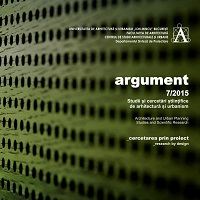INSERŢII URBANE ÎN ZONA CALEA CĂLĂRAŞILOR: CONCEPT, CONTEXT ŞI CONTINUITATE
URBAN INSERTS IN CALEA CĂLĂRAŞILOR AREA: CONCEPT, CONTEXT AND CONTINUITY
Author(s): Andrei Eugen LakatosSubject(s): Architecture, Rural and urban sociology, Sociology of Art
Published by: Editura Universitară “Ion Mincu”
Keywords: history; context; memory; concept; (urban) continuity;
Summary/Abstract: The history of humanity in its various aspects, including urban history, is like a big open book that is written and rewritten permanently, the present (continuous built) being nothing else but a(n) (in)writing ceaselessly in the great (urban) text. History is a continuous accumulation of material or immaterial layers this can be viewed as a (continuous) limit between past and future, and architecture, as a way to link in space all of the time periods. Today, contemporary architecture seems not to be born in a particular site, the image of an architecture of place (and time) being slowly removed. In the context of globalization (of architecture), when the boundaries determined by culture and geopolitics are removed, the need of distinct elements that can add character and value of an area it is felt, thus helping to preserve its identity. The concept of a project can be (as relation), neuter, under or in conflict with the context; therefore, a special attention should be shown to the integration of new buildings in a certain given context because, to build in context differs essentially from building with the context. Reporting to the context value, with its optimal and less optimal layers is important when discussing the architecture of the contents, of substance and not of the forms (without essence). Contemporary urban insertion should mean a conservation of place memory, thus preserving an architectural continuity and certain consistency morphology of spatiality place, as a basis for future urban interventions. The existence in the contemporary era requires the awareness that without the assemblage of the past we would not be able to speak today of a modern time with its specific characteristics. In order to find their identity, modern architecture cannot remove the temporal dimension of its concerns, its existence being certified by reference to the past, space and time being a continuous accumulation of successive layers of evolution.
Journal: Argument
- Issue Year: 2015
- Issue No: 7
- Page Range: 63-83
- Page Count: 21
- Language: English, Romanian

